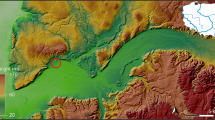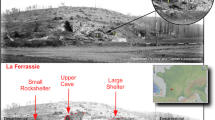Abstract
Lead isotope ratios of 15 Chinese bronze artifacts from the Yejiashan site (Suizhou City, Hubei Province) were analyzed and compared with copper ores across China. This study attempts to provide a new perspective to discuss the role that Zeng State played among all the vassal states in the early Zhou dynasty (ca. 1046–977 BC). The political presence of the Zhou dynasty in the middle Yangtze Plain is another main content of this paper. The lead isotopic characteristics of Chinese bronze artifacts between different historical periods are also in the scope of the study. By comparison, the lead isotopic ratios of the tested bronzes and copper deposits in the north Jiangxi Province show numerous overlaps. It indicates that the tested bronzes might have a single ore source, and this source was in the south of the Zhou dynasty. Combined with history and archaeological records, it is highly likely that the middle Yangtze Plain might be a part of the Zhou dynasty since the very beginning. Moreover, Zeng State might have a great influence in the ancient middle Yangtze Plain, and the nobles of Zeng State might even have authority to supervise certain area extending to Jiujiang. As lead isotopes of the bronzes appear to show a clear relation to chronology, the change of lead isotope patterns across times may further serve to distinguish the bronzes of the Western Zhou dynasty from the late Shang ones.





Similar content being viewed by others
References
Anhui Provincial institute of Archaeology, Tongling Cultural Relic Administration (1993) The ancient copper deposits in Tongling, Anhui. Archaeology 6:507–517 (in Chinese)
Baron S, Tămaş CG, Le-Carlier C (2014) How mineralogy and geochemistry can improve the significance of Pb isotopes in metal provenance studies. Archaeometry 56(4):665–680
Chen C, Wang BD, Niu SY, Zhang FX, Ma BJ, Zhang JZ, Sun AQ, Wang HT, Ma GX, Chen ZK, Wang ZL (2015) Discussion on the ore-forming material sources of Mujicun copper (molybdenum) polymetallic orefield in Laiyuan County, Hebei Province, China. J Jilin Univ (Earth Sci Ed) 45(1):106–118 (in Chinese with English title and abstract)
Cui JF, Wu XH (2008) The study of lead isotopic archaeology: provenance study of bronze artifacts unearthed from Yunnan Province, China and Vietnam. Cultural Relics Press, Beijing (in Chinese with English title and abstract)
Ding ZJ, Yao SZ, Zhou ZG (1999) Composition characteristics of Sr, Pb isotopes and implications for mineralization of Tongchang copper deposit, Lueyang, Shaanxi Province. Journal of Mineral Petrol 19(4):78–81 (in Chinese with English title and abstract)
Dong Q (2015) Characteristics and genesis of the Wushan copper deposit, Jiangxi Province. Doctoral thesis, China University of Geosciences, Beijing (in Chinese with English title and abstract)
Feng JZ, Ai X, Wu YB, Liu GP (1994) The stable isotopic geochemistry of the Dajing polymetallic deposit, Inner Mongolia. Jilin Geology 23(3):60–66 (in Chinese with English title and abstract)
Gale N, Stos-Gale Z (2000) Lead isotope analyses applied to provenance studies. In: Ciliberto E, Spoto G (eds) (2000) Modern analytical methods in art and archaeology. John Wiley & Sons Incorporated, Chicago
He GY (1995) A study on Ai State. Cultural Relics in Southern China 2(106–108):126 (in Chinese)
Henan Provincial Institute of Cultural Relics and Archaeology, Nanyang Municipal Institute of Cultural Relics and Archaeology, Zhenping Memorial Hall of Xuefeng Peng (2011) The Qiushuwan site in Zhenping County, Henan (in Chinese with English abstract)
Huangshi Museum (1992) The Tonglvshan site. Cultural Relics Press, Beijing (in Chinese)
Hubei Provincial Institute of Cultural Relics and Archaeology (2007) The bronze artifacts of Zeng State. Cultural Relics Press, Beijing (in Chinese)
Hubei Provincial Institute of Cultural Relics and Archaeology, Suizhou Municipal Museum (2011a) Tomb M65 of the Yejiashan site in Suizhou, Hubei. Jianghan Archaeology 120(3):3–40 (in Chinese)
Hubei Provincial Institute of Cultural Relics and Archaeology, Suizhou Municipal Museum (2011b) Yejiashan western Zhou graveyard in Suizhou, Hubei. Cultural Relics 11:4–60 (in Chinese)
Hubei Provincial Institute of Cultural Relics and Archaeology, Suizhou Municipal Museum (2012) The Yejiashan site of the western Zhou dynasty in Suizhou, Hubei. Archaeology 607(7):31–52 (in Chinese with English Abstract)
Hubei Provincial Institute of Cultural Relics and Archaeology, Suizhou Municipal Museum (2014) A preliminary excavation report on tomb M1 and M2 of Wenfengta cemetery in Suizhou. Jianghan Archaeology 133(4):3–51 (in Chinese with English title and abstract)
Jia LJ, Zhao CC, Jin PJ, Yang XG, Ling X, Liu XM, Guo YL, Jin L (2011) Preliminary analysis on a group of bronze weapons of early Qin period. Journal of Northwest University (Natural Science Edition) 1:67–72 (in Chinese with English abstract)
Jin R (2013) Scientific study on bronze artifacts of regional cultures of the Shang dynasty: case study of bronze artifacts unearthed from Yinxu and other sites of the Shang dynasty. Doctoral thesis, University of Chinese Academy of Sciences, Beijing (in Chinese with English title and abstract)
Jin ZY (2008) Lead isotope archaeology in China. Press of University of Science and Technology of China, Hefei (in Chinese with English title)
Li RL (2010) Analysis of bronze artifacts from western Liaoning. Master’s thesis, University of Science and Technology of China, Hefei (in Chinese with English abstract)
Li XQ (ed) (1999) Notes and commentaries of Lunyu. Peking University Press, Beijing (in Chinese)
Li YX (1993) A preliminary study of the Zhongtiaoshan site. Journal of Cultural Relics 2(64–67):78 (in Chinese)
Ling J, Hjärthner-Holdar E, Grandin L, Billström K, Persson P-O (2013) Moving metals or indigenous mining? Provenancing Scandinavian bronze age artefacts by lead isotopes and trace elements. J Archaeol Sci 40:291–304
Liu JY (2015) Scientific study on the Shang and Zhou periods bronzes unearthed from northern Shaanxi: cultural connections between loess highland and Anyang in the late Shang dynasty. Doctoral thesis, University of Science and Technology Beijing, Beijing (in Chinese with English title and abstract)
Liu SZ, Lu BS (1998) Excavation and study of the copper mine site at Tongling, Jiangxi. Acta Archaeologica Sinica 4:465–496 (in Chinese with English title and abstract)
Lu B (1985) Lu’s history studies. Zhonghua Book Company, Beijing (in Chinese)
Mu D, Song GD, Cui B, Wang HM, Wang W, Luo WG (2014) Provenance study on Chinese bronze artefacts of E in the Zhou dynasty by lead isotope analysis. J Archaeol Sci 52:515–523
Mu Y (2014) Research on the corrosion product of Chinese bronzes. Doctoral thesis, University of Chinese Academy of Sciences, Beijing (in Chinese)
Nan PH, Ma JB (2012) Pb isotope analyses of the bronzes from the cemetery of the western Zhou dynasty in Hengshui, Jiangxian. World of Antiquity 4:10–16 (in Chinese)
Peng ZC, Liu YG, Liu SZ, Hua JM (1999) A preliminary study on Shang dynasty bronzes and their Cu-Pb ore sources in Jiangxi, Hubei and Henan Provinces. Studies in the History of Natural Sciences 18(3):241–249 (in Chinese with English title and abstract)
Todt W, Cliff RA, Hanser A, Hofmann AW (1996) Evaluation of a 202Pb–205Pb double spike for high-precision lead isotope analysis. In: Hart SR, Basu A (eds) (1996) Reading the Isotopic Code. Earth Processes, Washington DC
Wang G (1994) The Dajing site in Linxi County. Cultural Relics and Archaeology in Inner Mongolia 119(1):45–50 (in Chinese)
Wang YB, Gu XX, Zhang ZB, Dong SY (2011) Isotopic geochemistry of the Tonglvshan Cu-Fe skarn type deposit in Hubei Province. Geoscience 25(4):730–739 (in Chinese with English title and abstract)
Wen J, Ling X, Zhao CC, Zhang ZY, Yao ZQ, Zong CL, Yuan HL, Wu Z (2013) Primary analysis on lead isotope characteristics in Chu State bronzes in east-Zhou period unearthed from Liu’an District, Anhui Province. Journal of Northwest University (Natural Science Edition) 43(6):1016–1020 (in Chinese with English title and abstract)
Xu QL (2010) Study on the geological characteristics and ore genesis of Tongkuangyu copper deposit in the Zhongtiaoshan Mountains, Shanxi Province. Master’s thesis, Jilin University, Changchun (in Chinese with English title and abstract)
Yu YB, Chang HY, Huang FC, Li L, Mei JJ, Chen JL (2014) Metallographic examination on the bronzes excavated from tomb M65 of Yejiashan site, Suizhou. Jianghan Archaeology 134(5):100–109
Zeng JN, Fan YX, Lin WB (2002) The lead and sulfur isotopic tracing of the source of ore-forming material in Jinshan gold deposit in Jiangxi Province. Geoscience 16(2):170–176 (in Chinese with English title and abstract)
Zhang CP (2009) The research on the bronzes of the Zeng State. Cultural Relics Press, Beijing (in Chinese with English title and abstract)
Zhang Q (1994) Lead isotopic compositions of Huangren polymetallic ore deposit, Liaoning Province: evidence from phanerozoic single-stage mantle-source lead. Geochimica 23(12):32–38 (in Chinese with English title and abstract)
Zhou BH (2001) Criticisms and explanations on Yizhoushu. Social Sciences Academic Press, Beijing (in Chinese)
Zhu HP (1998) Geochemistry of the Qiushuwan breccia copper deposit. Geological Exploration for Non-Ferrous Metals 7(4):228–233 (in Chinese with English title and abstract)
Acknowledgements
This research is supported by the Junior Fellowships for CAST Advanced Innovation Think-tank Program (DXB-2KQN-2016-031), the National Scholarship Fund of China (CSC No. 201404910198), the Special Foundation for Young Scholar’s Teaching and Research in Scientific History at Chinese Academy of Sciences (2015), the National Social Science Fund of China (No. 13BKG004), and the National Natural Science Foundation of China (Grant No. 41471167). The authors would also like to thank the Research Reactor Center at University of Missouri for supporting Dr. Luo Wugan’s 1-year visit in USA.
Author information
Authors and Affiliations
Corresponding author
Additional information
Di Mu and Wugan Luo contributed equally to the manuscript and should be regarded as co-first authors.
Rights and permissions
About this article
Cite this article
Mu, D., Luo, W., Huang, F. et al. The bronze artifacts from the Yejiashan site and the political presence of the Zhou dynasty in the middle Yangtze Plain: an application of lead isotope analysis. Archaeol Anthropol Sci 10, 1547–1555 (2018). https://doi.org/10.1007/s12520-017-0478-5
Received:
Accepted:
Published:
Issue Date:
DOI: https://doi.org/10.1007/s12520-017-0478-5




